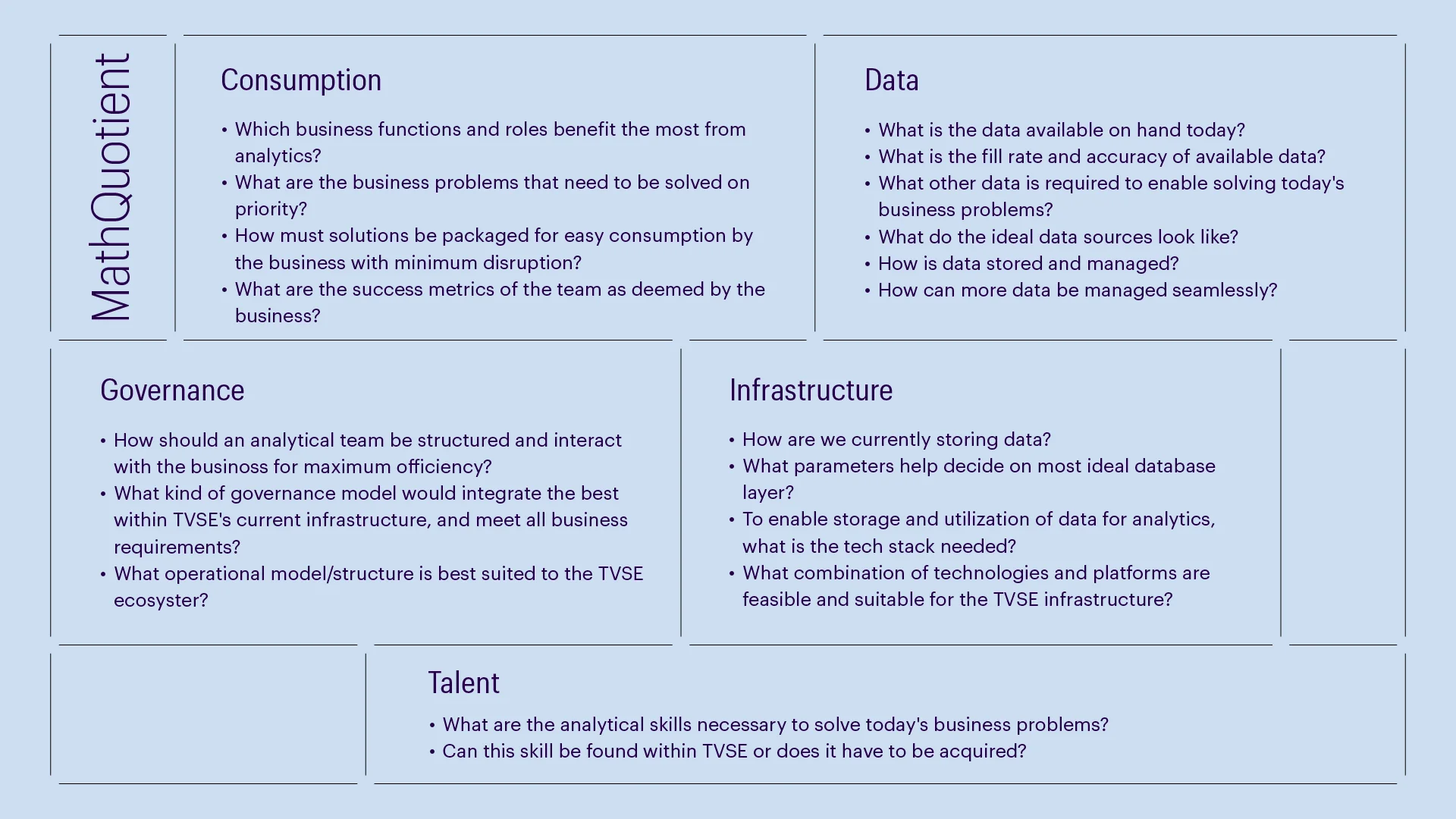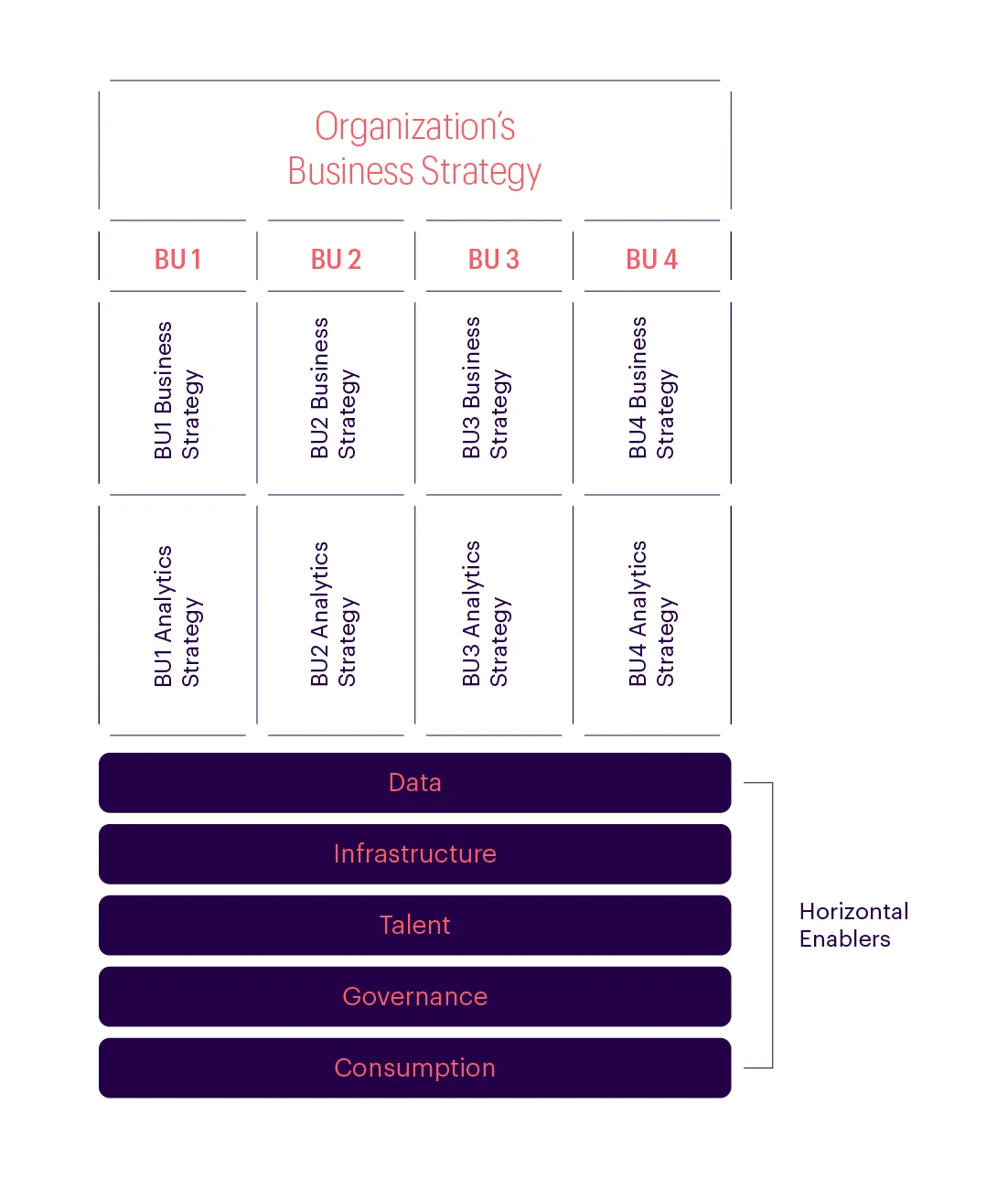Having a holistic top-down perspective of the why, what and how of analytical transformation of your organization is essential to provide effective leadership and directional clarity to the organization as a whole. While setting an Analytics Transformation Strategy is narrowed down to the specifics of the industry and company, here we attempt to abstract from our experience and present a few generic guidelines, so you know the trade-offs involved in making certain choices.
Analytics vision:
In most organizations, the analytical journey begins with some leaders taking initiatives within their functions and applying it in specific use cases. As momentum gathers, one leader (most commonly, the CIO) takes charge of making it a centralized effort and puts together various enablers like data and infrastructure so that any function that wants help in Analytics gets enough support. In parallel, through a combination of central push and competitive pressure, business leaders and middle managers develop analytics awareness at a large scale, resulting in them seeking analytics support for many business initiatives/decisions; the data scientist gets the proverbial “seat on the table”. That’s when an organization can be safely referred to as Analytically Enabled.
Some organizations that choose to go beyond this, take the tougher path and re-invent their business or operating model, so that analytics is the primary source of competitive advantage. This is a higher level of analytical maturity and has helped organizations secure market leadership for sustained periods. We shall refer to them as “Analytical Competitors”. For example, Netflix’s and YouTube’s recommendation systems, Amazon’s inventory management, Walmart’s assortment optimization and pricing have been driving their revenue or cost leadership. Being analytically enabled is not a choice anymore – success is determined by how quickly you get there; whereas every organization has to make a choice of if and how they want to become analytical competitor. Understanding where your organization is in the journey today and where you want it to reach, and then building a consensus around that vision is the first step towards a good analytics strategy.
While formulating a vision, it is important to try not to mimic an Amazon or a Google. Every organization has to develop a vision that augments its unique strengths and fits its native culture and the realities of the industry. Try to be the best P&G or Walmart or Shell that you can be, rather than trying to emulate digital native companies.
Competitive benchmarking:
While formulating your vision and roadmap, it is imperative that you are aware of where you stand vis-à-vis your competition and ideal self. That makes your strategy and expectation grounded in realities. In this regard, we recommend that you benchmark your organization against competition and peer companies on five major dimensions. Data, infrastructure, analytics talent, governance & processes, analytics adoption / consumption-appetite. Figure 1. offers pointers on what questions to answer in the benchmarking exercise.

Another way to determine the benchmark is to look for the best in each functional area and get an inspiration on what the current gold standard is. For example, if you are a FMCG company and conjoint-based pricing is one of your key functional areas, find the organization that is the gold standard in conjoint-based pricing, irrespective of which industry it represents. That doesn’t mean you should try to emulate them, but it should be one of the inputs and inspiration while determining your vision and roadmap for pricing.
Based on the benchmarking exercise on the five dimensions, you should create a roadmap for each of them, so that they collectively support and enable the greater organizational vision for analytics.
The analytical strategy pillar:
The purpose of analytics is to serve business goals and not vice-versa. Analytics is just another tool like electricity, internet and the computer, that has sole purpose of furthering business interests. Keeping this in mind, formulate a strategic vision that the transformation exercise will drive in each function. For example, from a marketing perspective, “in 18 months, we aim to make all our customer interactions personalized” (a business purpose) is better than “in 18 months we will have only bots interact with our customers” (a technology purpose). Each of these functional visions, in turn, have to be in line with the greater organizational vision for the business.

Figure 2. defines Analytical Strategy Pillar structure.
1. Start with the organization’s larger business goals and strategy.
2. Break it down to strategy and goals of each BU / function.
3. This should in turn decide what should be the analytics goals and strategy for each BU/ function.
4. The analytics support teams for each BU/ function should be supported by horizontal enablers, as depicted in Figure 2.
5. The Strategy Pillar also provides the foundation for analytics governance and organization structure, that we shall discuss in a later section.
Use case definition and roadmap:
The most common dilemma organizations face is whether they should get (internal) customers first or formulate a team first. In our experience, from studying the transformation pattern of many organizations, we have noticed that three things have to happen in parallel for the analytics strategy to materialize; awareness and enlisting of middle managers (Directors, in most organizations) to champion the first few use cases, creation of the right analytics development team – either inhouse or outsourced, and development of a few translators that can liaison between the two groups.
From a use case perspective, the first few use cases for each function should satisfy three criteria. Firstly, it should have a demonstratable impact – ideally measurable monetary impact. Secondly, the effort should be relatively low, so that the results can be obtained within 3-4 months. And most importantly, it must have a strong champion on the business side who can invest time to iterate with the analytics team and help them get it right. This makes it easier to utilise these use cases as proofs of concept and evangelize further in the organization, to get more demand for analytics. But as the organization matures, remember the role of analytics as an enabler of many decisions – not every project needs to have a “dollar” ROI impact, as long as it contributes to better decisions or customer experience, and, as a leader you “feel” that it is taking you in the right direction.
Also, beyond the first few use cases, the roadmap should be guided by how the competition is shaping up in your industry. There will eventually be some use cases that become the industry norm, (like assortment and shelf space optimization in retail, risk score-carding and collections optimization in consumer banks), that you might want to pursue just to stay in the game. And you should look for use cases beyond these, to gain a competitive advantage. This segregation should also guide the organizational structure of your analytics teams, which we will discuss in a later section.
The captain of the ship:
If you are serious about the transformation, it is imperative to have an experienced member of your staff lead the initiative. The person should be deeply invested in the culture of the organization, well-connected across BUs and geographies and know how to ‘make things happen’. It is an intrapreneurial role and the personality should match the requirements of such a role. In addition to this, the required skill set would be a basic awareness of analytics and perspective on how it can take each function forward.
How do you measure the impact?
While on one extreme, companies pursue analytics use cases just to sound cool or to appear resourceful to the senior management, the other extreme is where companies ask for financial justification before beginning each analytics project. Neither of them is a healthy practice. There are analytics projects that do provide direct monetary impact, and there are many that are enablers of decisions. For example, a forecasting project or a customer segmentation project may provide inputs that assist in making bigger decisions and do not provide direct measurable value. But investing in them might make many downstream decisions better. As long as the initiative takes the organization forward in terms of revenue, cost efficiency, or customer experience, or is going to make downstream decisions better, it is a good candidate.
Remember that you are on to a cultural transformation. The right measure is the change in culture itself. A shift in culture is best measured by observation of interactions by neutral third parties and by hyper-customized behavioural interviews.
Do not get hung up on technical definitions of skills and roles:
In general, there are no pure-play analytics projects, tech projects, automation projects or visualization projects. Most initiatives will involve a combination of these, and a cross-functional team will be required to ensure success. And larger change management effort will be involved in getting people to use the new applications on a consistent basis. As such, don’t “box” these roles and projects at an executive level. Leave it to the analytics manager who is heading the initiative and let her staff the right experts to make the initiative successful and deliver business results.
At an executive level, you have to ensure two things. One, the CIO organization has access to Data Science as well as all the peripheral skills that are required to make analytics initiatives successful – Data Engineering, Visualization, Automation / RPA, Application Development, etc – either through in-house teams or consultants. Two, low level and mid-level management is staffed with a bunch of generalists who can understand and execute all the above aspects of a project.
While there is no one-size-fits-all framework to arrive at the right analytics strategy, following the above guidelines will offer you much better chances of starting off on the right foot and cruising through the journey.
Making design count in problem-solving:
Despite common perception that design is just a form of creative expression that graphic designers utilise for visualization purposes, it can prove to be a powerful problem-solving tool. Along with data and digital technologies, design can solve a myriad of problems in elegant ways. While design thinking can be used to solve pretty much any problem, they are especially useful in solving muddy and fuzzy problems that are not well-defined and open-ended. The best way to accelerate your analytical transformation is to adopt design thinking as a default way to approach any problem in the organization. Develop a Design Thinking Culture as the foundation for Analytical / Data-Driven Culture.
In the next part of this series, we will do a deep dive into how to go about creating large-scale analytics awareness and mindset transformation in the organization.